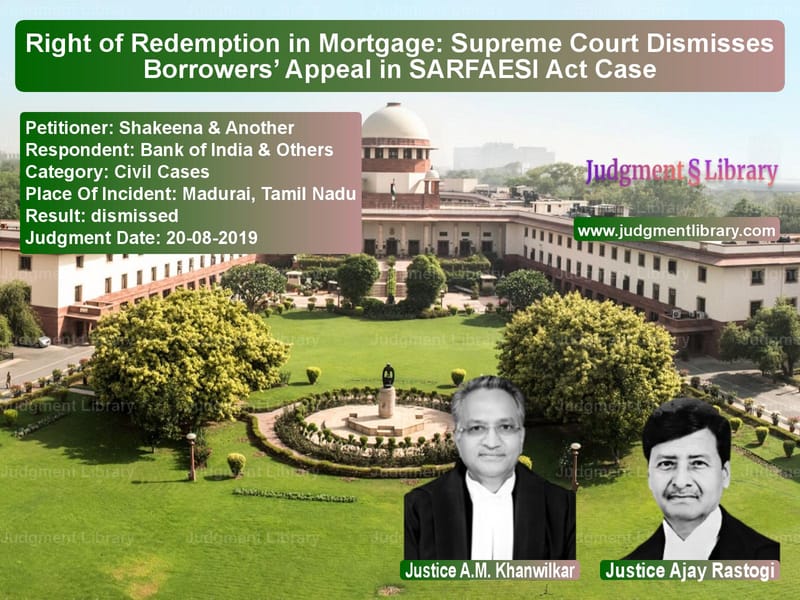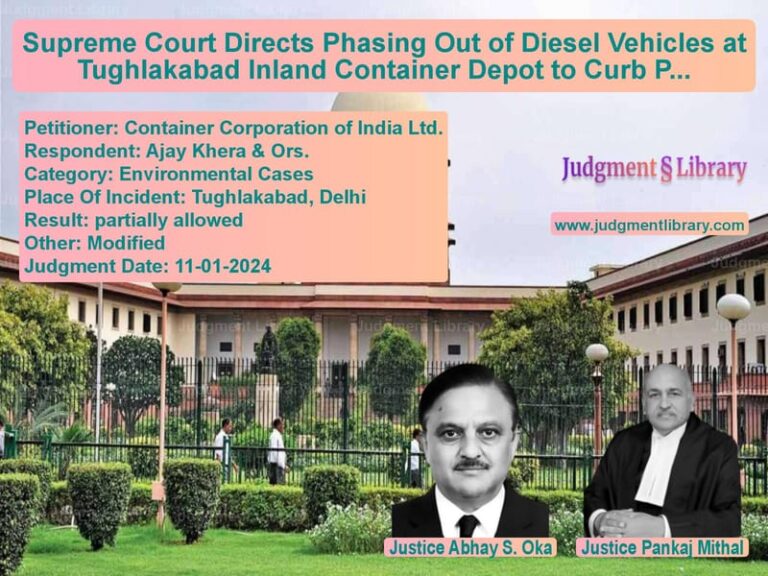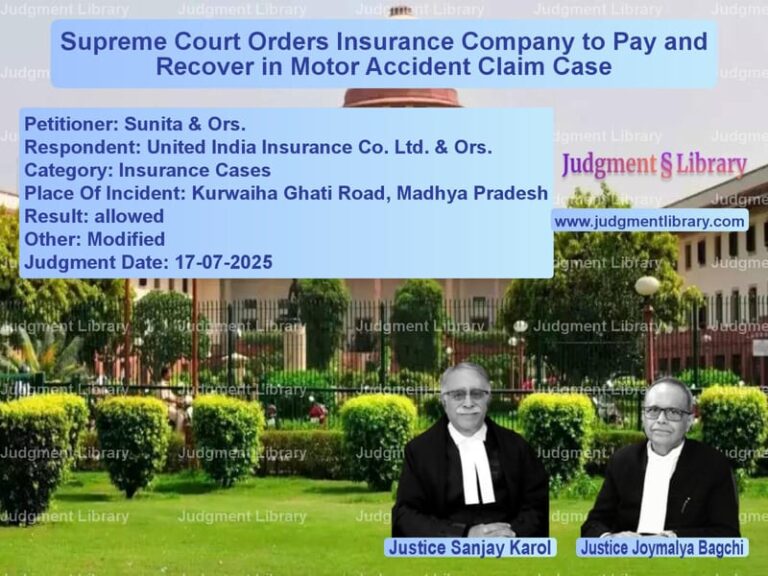Right of Redemption in Mortgage: Supreme Court Dismisses Borrowers’ Appeal in SARFAESI Act Case
The case of Shakeena & Another v. Bank of India & Others revolves around the crucial issue of a borrower’s right to redeem a mortgaged property after it has been auctioned under the Securitisation and Reconstruction of Financial Assets and Enforcement of Security Interest Act, 2002 (SARFAESI Act). The dispute centered on whether the borrowers, Shakeena and P. Shahul Hameed, could redeem their property after the auction had been concluded but before the sale certificate had been registered.
The Supreme Court ruled against the borrowers, emphasizing that the right of redemption under Section 13(8) of the SARFAESI Act ceases once the auction is concluded and the sale certificate is issued. This judgment clarifies the legal position on when a borrower’s right to reclaim their property is extinguished in foreclosure proceedings.
Background of the Case
The case originated from a financial dispute between the borrowers and the Bank of India. In 2003, the bank sanctioned term loans of ₹10 lakhs each to the borrowers under the Star Mortgage Loan scheme. However, due to defaults in repayment, their accounts were classified as Non-Performing Assets (NPA) on June 30, 2004.
Following this classification:
- The bank issued a legal notice on October 19, 2004, demanding repayment within seven days.
- On December 1, 2004, a notice under Section 13(2) of the SARFAESI Act was sent, giving 60 days for repayment.
- Despite requesting extensions, the borrowers failed to regularize their accounts.
- On February 8, 2005, the bank took constructive possession of the mortgaged property under Section 13(4) of the Act.
Subsequently, the bank initiated a public auction for the property:
- A sale notice was issued on November 14, 2005.
- The auction took place on December 19, 2005.
- Respondent No.3 (Chidhamaramanickam) was declared the highest bidder with a bid of ₹42.51 lakhs.
- A sale certificate was issued in his favor on January 6, 2006.
Borrowers’ Attempt to Redeem the Property
The borrowers attempted to redeem their property by:
- Depositing ₹25.21 lakhs via cheques on January 2, 2006.
- Sending demand drafts of ₹25.06 lakhs on January 18, 2006.
- Filing a writ petition on January 19, 2006, seeking to quash the auction and direct the bank to accept their repayment.
However, the bank rejected their payments, stating that:
- The cheques and demand drafts were not a valid tender under the loan agreement.
- The redemption attempt came after the auction had been concluded.
- Under Section 13(8) of the SARFAESI Act, borrowers lose the right of redemption once the sale is finalized.
Arguments by the Petitioners (Borrowers)
The borrowers contended that:
- They had the right to redeem the mortgage until the sale certificate was registered.
- The bank unfairly rejected their repayment efforts.
- The reserve price of ₹40 lakhs did not reflect the true market value of ₹2 crores, leading to an unfair sale.
- The subsequent sale of the property by the auction purchaser was invalid under the doctrine of lis pendens (a legal principle preventing the transfer of disputed property).
Arguments by the Respondents (Bank of India & Auction Purchaser)
The bank and the auction purchaser countered these claims by arguing that:
- The borrowers failed to exercise their right of redemption within the legally prescribed period.
- The sale certificate was issued on January 6, 2006, making the sale final.
- The borrowers had sufficient notice and opportunities to settle their dues before the auction.
- The subsequent registration of the sale certificate was only a procedural formality and did not affect the finality of the sale.
Key Observations by the Supreme Court
The Supreme Court ruled against the borrowers, making the following key observations:
- The right of redemption ceases once the auction is concluded: The Court held that the borrowers had failed to exercise their right before the auction, and under Section 13(8) of the SARFAESI Act, the sale was final once the highest bid was accepted and the sale certificate was issued.
- Registration of the sale certificate is not required for finality: The Court relied on B. Arvind Kumar v. Govt. of India (2007) and B. Arvind Kumar v. Govt. of India (2014) to establish that sale certificates issued in public auctions do not require registration to be legally effective.
- The borrowers failed to make a valid tender: Their payments were either delayed, made through incorrect channels, or not in accordance with loan terms.
- The bank acted in accordance with the law: It provided adequate notice and followed due process in conducting the auction.
Final Judgment
The Supreme Court dismissed the appeal, stating:
“We find that the borrowers failed to exercise their right of redemption in a timely and legal manner. The sale certificate issued on January 6, 2006, was final, and the subsequent registration did not affect the validity of the auction.”
The Court also upheld the bank’s decision to reject the borrowers’ late payment attempts and confirmed that the auction purchaser had lawfully acquired the property.
Implications of the Judgment
This ruling has significant implications:
- Clarification on the right of redemption: Borrowers must repay outstanding dues before the auction to retain their property.
- Finality of sale certificates: Once issued, sale certificates conclusively transfer ownership, even if registration occurs later.
- Due process in foreclosure cases: Banks must ensure transparency, but borrowers must act within prescribed timelines.
- Protection of auction purchasers: Courts will uphold the rights of bona fide purchasers who comply with auction terms.
Conclusion
The Supreme Court’s ruling in Shakeena & Another v. Bank of India & Others reinforces the principle that a borrower’s right of redemption under the SARFAESI Act is strictly limited. Once an auction is conducted and the sale certificate is issued, the sale becomes final, and borrowers cannot reclaim the property by making late payments.
This judgment serves as an important precedent, ensuring that foreclosure proceedings are conducted efficiently while protecting the interests of both lenders and auction purchasers. Borrowers facing financial distress must act swiftly to clear their dues before the auction stage to avoid losing their mortgaged assets permanently.
Petitioner Name: Shakeena & Another.Respondent Name: Bank of India & Others.Judgment By: Justice A.M. Khanwilkar, Justice Ajay Rastogi.Place Of Incident: Madurai, Tamil Nadu.Judgment Date: 20-08-2019.
Don’t miss out on the full details! Download the complete judgment in PDF format below and gain valuable insights instantly!
Download Judgment: Shakeena & Another vs Bank of India & Othe Supreme Court of India Judgment Dated 20-08-2019.pdf
Direct Downlaod Judgment: Direct downlaod this Judgment
See all petitions in Property Disputes
See all petitions in Debt Recovery
See all petitions in Specific Performance
See all petitions in Judgment by A M Khanwilkar
See all petitions in Judgment by Ajay Rastogi
See all petitions in dismissed
See all petitions in supreme court of India judgments August 2019
See all petitions in 2019 judgments
See all posts in Civil Cases Category
See all allowed petitions in Civil Cases Category
See all Dismissed petitions in Civil Cases Category
See all partially allowed petitions in Civil Cases Category







